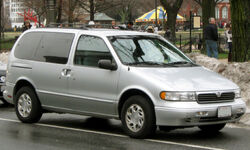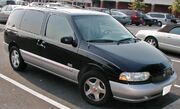 | |
| Manufacturer | Ford Motor Company |
|---|---|
| Also called | Nissan Quest |
| Production | 1993–2002 |
| Assembly | Avon Lake, Ohio, USA |
| Successor | Mercury Monterey |
| Class | Minivan |
| Layout | FF layout |
| Platform | Ford VX54 platform |
| Transmission(s) | 5-speed automatic |
| Wheelbase | 112.2 in (2850 mm) |
| Designer | Moray Callum |
The Mercury Villager was a minivan, marketed by Ford from model years 1993-2002. A rebadged variant of the Nissan Quest, the Villager was a product of a joint venture between Ford Motor Company and Nissan and was built at Ford's Ohio Assembly plant in Avon Lake, Ohio.
The Villager was unrelated to the Ford Aerostar, the Ford Windstar, the Ford Freestar or the Mercury Monterey.
First generation[]
 | |
| Production | 1993–1998 |
|---|---|
| Body style(s) | 3-door minivan |
| Engine(s) | 3.0 L 151 hp (113 kW) VG30E V6 |
| Length |
189.9 in (4823 mm) (1993–95) 190.2 in (4831 mm) (1996–98) |
| Width |
73.7 in (1872 mm) (1993–95) 73.8 in (1875 mm) (1996–98) |
| Height |
67.6 in (1717 mm) (1993–95) 67.5 in (1715 mm) (1996–98 GS Cargo) 65.9 in (1674 mm) (1996–98 GS) 65.6 in (1666 mm) (1996-98 Nautica & LS) |
| Curb weight | 3,815 lb (1,730 kg) |
The first-generation Villager was available in three trim levels: GS, LS, and the luxury Nautica Special Edition. All Nautica models came with a two-toned blue and white, paint scheme, an elegant yellow pinstripe, second row captain's chairs, and blue and white, or grey leather upholstery.
The Villager carried the code name "VX54" within Ford. The Villager received a minor freshening in 1996 that included a new front fascia — removing the front light bar — and redesigned taillights.
Second generation[]
 | |
| Production | 1999–2002 |
|---|---|
| Body style(s) | 4-door minivan |
| Engine(s) | 3.3L 180 hp (134 kW) VG33E V6 SOHC |
| Length |
194.7 in (1999–2000) 194.9 in (2001–02) |
| Width | 74.9 in (1902 mm) |
| Height | 70.1 in (1781 mm) |
| Curb weight | 3,944 lb (1,789 kg) |
The Villager was redesigned alongside the Quest for 1999, and facelifted for 2001, but sales remained slow. Ford pulled the plug after a brief run of 2002 models were produced, ending the Ford and Nissan joint venture. Nissan pursued the development of the 2004 Nissan Quest while Mercury received a version of the Ford Freestar called the Monterey. The second-generation Villager was available in three trim levels: Base, Sport, and the luxury Estate.

1999–2000 Mercury Villager
Innovations[]
The Villager's main innovation was in its seating configurations. At the time, minivans had bulky seats that folded over and usually could be removed. The GM minivans offered the first modular removable seats which were notably uncomfortable. The Villager had a folding removable middle seat (or two buckets). The rear seat folded and moved on tracks in the floor. It could be slid forward to the middle position making a 5 passenger vehicle with ample cargo space, or all the way to the back of the front seats to make a large cargo space. The seat was not removable however, and the system was not improved in the 1999 redesign (on which the model wouldn't be sold in Canada anymore), so newer fold into the floor seats and lightweight buckets quickly eclipsed the system.
Other uses of the name[]
"Villager" first appeared at Ford as the name of the Edsel station wagon, the Edsel Villager, in 1958. The Villager name resurfaced at Mercury on a woodgrained Comet station wagon from 1962 to 1967, and subsequently on similarly trimmed wagons in other Mercury series, including the Montego (1970–1976), Bobcat (1975–1980), Cougar (1977 and 1982), Zephyr (1978–1981) and Lynx (1981–1984). On Mercuries, the Villager name almost always denotes a top trim, wood grained wagon. Villager was the equal of the Ford designation "Squire". The Mercury equivalent of the more well known Country Squire full-size station wagon was the Colony Park.
Sales[]
| Calendar Year | American sales |
|---|---|
| 1999[1] | 45,315 |
| 2000 | 30,443 |
| 2001[2] | 22,046 |
| 2002[3] | 16,442 |
References[]
| This page uses some content from Wikipedia. The original article was at Mercury Villager. The list of authors can be seen in the page history. As with Tractor & Construction Plant Wiki, the text of Wikipedia is available under the Creative Commons by Attribution License and/or GNU Free Documentation License. Please check page history for when the original article was copied to Wikia |
- ↑ "Ford Motor Company Sets New Full Year U.S. Sales Record". Theautochannel.com. Retrieved on 2009-04-28.
- ↑ "Ford Motor Company's December U.S. Sales Climb 8.2 Percent". Ford Motor Company.
- ↑ "Ford's F-Series Truck Caps 22nd Year in a Row as America's Best-Selling Vehicle With a December Sales Record". Theautochannel.com (2004-11-17). Retrieved on 2009-04-28.
| ||||||||||||||
| « previous – Mercury passenger vehicle timeline, 1980–2011 | ||||||||||||||||||||||||||||||||
|---|---|---|---|---|---|---|---|---|---|---|---|---|---|---|---|---|---|---|---|---|---|---|---|---|---|---|---|---|---|---|---|---|
| Type | 1980s | 1990s | 2000s | 2010s | ||||||||||||||||||||||||||||
| 0 | 1 | 2 | 3 | 4 | 5 | 6 | 7 | 8 | 9 | 0 | 1 | 2 | 3 | 4 | 5 | 6 | 7 | 8 | 9 | 0 | 1 | 2 | 3 | 4 | 5 | 6 | 7 | 8 | 9 | 0 | 1 | |
| Subcompact | Bobcat | Lynx | Tracer | |||||||||||||||||||||||||||||
| Compact | Tracer | Tracer | ||||||||||||||||||||||||||||||
| Zephyr | Topaz | Topaz | Mystique | |||||||||||||||||||||||||||||
| Mid-size | Monarch | Marquis | Sable | Sable | Sable | Sable | Milan | |||||||||||||||||||||||||
| Full-size | Marquis | Grand Marquis | Grand Marquis | Grand Marquis | Grand Marquis | |||||||||||||||||||||||||||
| Colony Park | ||||||||||||||||||||||||||||||||
| Marauder | Montego | Sable | ||||||||||||||||||||||||||||||
| Sport compact | Capri | Capri | ||||||||||||||||||||||||||||||
| LN7 | Cougar | |||||||||||||||||||||||||||||||
| Personal | Cougar | Cougar | Cougar | |||||||||||||||||||||||||||||
| SUV | Mariner | Mariner | ||||||||||||||||||||||||||||||
| Mountaineer | Mountaineer | Mountaineer | ||||||||||||||||||||||||||||||
| Minivan | Villager | Villager | Monterey | |||||||||||||||||||||||||||||